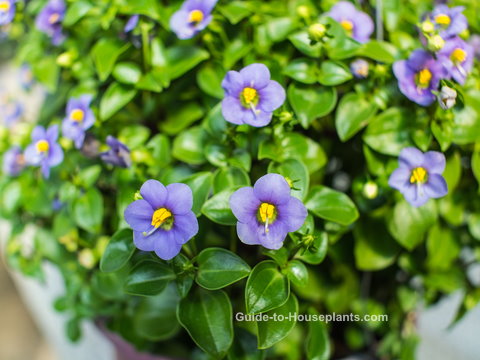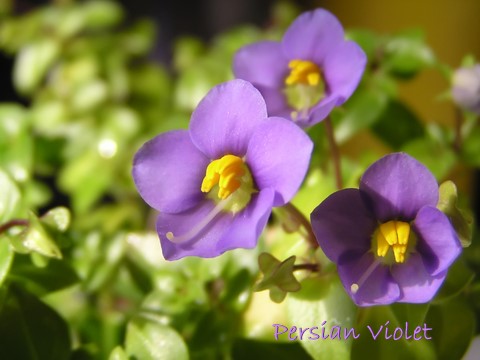Persian Violet
Botanical Name: Exacum affine
Typically called Persian Violet, this beautiful flowering house plant isn't a true violet at all. It's in the Gentianaceae family, and more closely related to garden-variety impatiens.

Violet-blue, 5-petaled flowers are studded with yellow centers -- called eyes -- and rise above a mound of small, glossy, green leaves. The flowers are wonderfully fragrant. Rarer varieties have white or purple flowers, and a few have double blooms.
Exacum affine is a biennial, although it is usually treated as an annual and tossed out after flowering. If you want to overwinter the plant, prune it back harshly and keep it above 60°F/16°C. You can collect its seeds the second year.
Commercial growers raise this flowering plant from seed and it is usually sold as an indoor plant in spring and summer.
Choose a plant with plenty of buds that are just beginning to open, and you'll enjoy several weeks of blooms. You may find Persian Violet for sale by other names: German Violet or Arabian Violet.
Don't repot your plant while it is in bloom, because it will likely drop its flowers and flower buds. If you want to cover up a plain nursery pot, set it in a cachepot or other decorative container.
Make Your Persian Violet Bloom
With good care, you can expect your "bouquet" of violets to last for a few months.
Pinch off flowers after they fade to promote more blooms.
Got a reluctant bloomer? Move your plant to a brighter location, yet out of direct sun. Raise the humidity around it by placing the pot on a tray of wet pebbles. Sometimes plants are in shock when you bring them home because they are adjusting to new light and humidity levels. Follow the tips here and you should see new buds and blooms in a couple weeks.
Dropped flower buds? This is not unusual when you buy a new plant. Plants are stressed by their new environment when you bring them home. Set your plant in bright, indirect light and keep it there. Raising the humidity around your Persian Violet may help. Never repot a plant in bloom, which will also cause buds to drop.

Persian Violet Problems, Solutions and Answers
Wilted plant? Keep the soil moist at all times, but don't overwater. Dry soil will cause flowers to fade quickly. If you're watering regularly and the plant wilts, root rot is likely. This is the most common problem with this plant. Slip the plant out of the pot and take a peek at its roots. Are they soft, black and mushy? That's a sign of root rot -- toss the plant, it won't recover.
Something bugging your houseplant? Spider mites are perhaps the most dreaded plant pest. They are so tiny, you'll likely only notice their webbing between stems. Left unchecked, they'll suck plant juices from the leaves, turning them dull, faded and specked with yellow. Spider mites are attracted to dry conditions and are most likely to attack a houseplant during the winter months, when indoor air tends to be dry. Prune off any affected stems, clean the plant by spraying it with room-temperature water. Is your plant badly infested? Get rid of it. Raising the humidity for Persian Violet will help to prevent an invasion.
Persian Violet Care Tips
Origin: Socotra Island near East Africa
Height: 8-12 in (20-30 cm)
Light: For the most blooms, give Persian violet bright filtered light from a south- or west-facing window. Some direct morning sun is fine, but keep out of hot, afternoon sunlight which can scorch the plant.
Water: Keep soil evenly moist, but not soggy. Use a pot with drainage holes, water thoroughly then empty drainage tray. If your plant collapses despite regular watering, it likely has root rot. If this happens, toss it out -- it won't recover. Always use room-temperature water for your house plants because cold water is a shock to them.
Humidity: Aim to maintain 50% relative humidity or higher. Place pot on a tray of wet pebbles or use a cool-mist room humidifier near the plant.
Temperature: Average room (65-75°F/18-24°C). Keep the plant away from drafts, including heat/AC vents.
Soil: Exacum affine likes slightly acidic potting medium. African violet potting mix is ideal. Or use other peat-moss based potting mix with added perlite.
Fertilizer: Feed every 2 weeks while the plant is growing and blooming with a balanced (such as 10-10-10 NPK) water-soluble fertilizer.
Propagation: Seeds will germinate in 2-3 weeks. The seeds are tiny. Sow seeds in winter or early spring on top of moist potting mix in a shallow pot.


